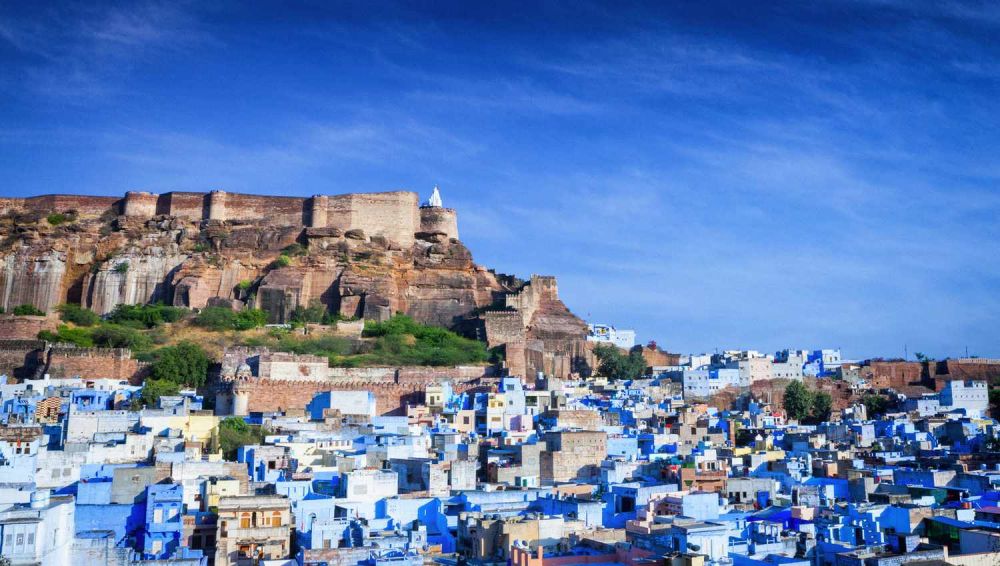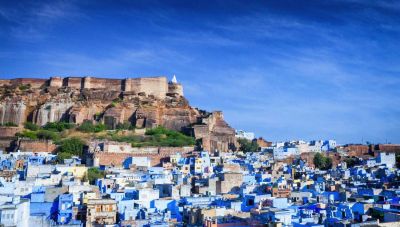

Mehrangarh Fort, one of the largest forts in India, is a breathtaking attraction in the heart of Jodhpur. When you visit this magnificent 15th-century fort, you will be taken on a journey through Rajasthan's royal history. As you walk through its impressive gates and sprawling courtyards, you will be treated to spectacular views of the Blue City and beyond. Inside the fort, there's a well-stocked museum with an extensive collection of artifacts that tell tales of the bygone era, including royal palanquins, costumes, paintings, and decorated period rooms. The audio guide available in multiple languages, narrated by the current Maharaja, enriches the experience, providing historical context and fascinating anecdotes. The fort is an exemplar of Rajput architecture with intricate carvings and expansive, ornate rooms.
Jaswant Thada, often described as the 'Taj Mahal of Marwar,' is a serene white marble cenotaph located just a stone's throw away from Mehrangarh Fort. Built in the memory of Maharaja Jaswant Singh II by his son in 1899, this architectural landmark serves as a burial ground for the royal family of Marwar. The main cenotaph features portraits of various Rajput rulers and is a fine example of classical Rajputana architecture. As you explore the peaceful gardens and gaze at the intricately carved marble lattice screens, you'll appreciate the craftsmanship that reflects the mausoleum's royal legacy. Jaswant Thada is an oasis of calm, offering a reflective space with stunning panoramic views of the surrounding area.
Umaid Bhawan Palace, completed in 1944, is a magnificent piece of Rajasthan's heritage and a symbol of new Jodhpur. Home to the royal family of Jodhpur, part of this grand palace is now run as a luxury hotel while the remaining serves as a museum that provides public insight into the regal living of the past. The museum showcases an exclusive range of items belonging to the Maharaja and the royal family, including an array of fine china, crystal, vintage cars, clocks, and unique photographs of the royal family. The Classic Art Deco interior of the palace is a contrast to the traditional Rajput exterior, making it a fascinating study in architectural styles. Visitors can also appreciate the lush gardens before enjoying a sumptuous high tea at the hotel's café.
Adjacent to Mehrangarh Fort lies the Rao Jodha Desert Rock Park, spread over 72 hectares and restored after years of neglect. Established in 2006 to restore the natural ecology of a large, rocky wasteland, the park contains native plant species that once flourished in the area. Trails have been laid out for tourists that wind between rocky outcrops and offer a unique chance to see the flora and fauna of the Thar desert environment. Visitors will be surrounded by volcanic rocks and sandstone formations that provide a surreal background for the lush green vegetation. It's also a great place for bird watching and to experience the desert ecosystem up close. The park is a testament to how native vegetation can be re-established with sustained efforts.
The maze-like streets of the Blue City of Jodhpur are a glimpse into the vibrant lifestyle of its residents. This guided walking tour takes you through ancient alleys lined with indigo-blue houses, which is why Jodhpur is known as the Blue City. A guide will explain the reasons behind the painted houses while introducing you to local craftsmen in their workshops, bustling markets selling everything from vegetables to jewelry, and friendly locals who often invite travelers into their homes for a cup of chai. This walking tour is more than just sightseeing; it is an immersion into the cultural and social heartbeat of the city. You'll have the opportunity to taste local snacks, watch artisans at work, and perhaps even have a spiritual experience at one of the many temples you'll come across.
A visit to the Bishnoi villages around Jodhpur is an excursion into the heart of rural Rajasthan where you can witness the life of the Bishnoi community, known for their commitment to protecting nature. The safari allows visitors to see the traditional rural Rajasthani lifestyle. You'll likely encounter wildlife such as blackbucks, chinkaras, blue bulls, desert foxes, and migratory birds. The local citizens are warm and welcoming, inviting you into their mud huts to share their way of life, showcasing handicrafts like pottery and hand weaving. These safaris often include a demonstration of opium tea, a traditional local custom. It's a culturally enriching experience that shows a stark yet beautiful contrast to the urban life of Jodhpur.
Located in the heart of Jodhpur, the Sardar Market and Clock Tower is a bustling open marketplace that provides an authentic local shopping experience. The market is teeming with everything from spices, Indian sweets, textiles, silver and handicrafts. The sound of locals bargaining, the rich aroma of street food, and the array of colors make it a lively place to visit. The clock tower, also known as Ghanta Ghar, is a prominent landmark dating back to the 19th century. You can shop for souvenirs such as traditional bandhej fabric, mojari shoes, or sample local delicacies like pyaaz kachori and makhaniya lassi. Remember, bargaining is expected, so do your homework and start practicing your negotiation skills for the best deals!
Just a short drive from the center of Jodhpur, the Mandore Gardens are home to a collection of temples, memorials, and government museum. Mandore was the former capital of the Marwar region before Jodhpur was established. Visitors can marvel at the ruins of the old Mandore fort and the beautiful cenotaphs (chhatris) of the Marwar rulers. Within the landscaped gardens, you'll find locals enjoying picnics, and you have the opportunity to see the Hall of Heroes and a temple to 33 crore gods. The museum provides a deeper understanding of the local history. Although less frequently visited than other Jodhpur attractions, the tranquility and historic significance of this place make it well worth a visit.
For adventure seekers, zip lining at Mehrangarh Fort provides an exhilarating experience with an extraordinary perspective of the fort and its surroundings. Operated by Flying Fox, the activity includes six zip lines that crisscross the fort's ramparts and lakes. You will get a bird's-eye view of the fort's architecture and the surrounding blue city below. Instructors ensure safety and provide a quick training session before you begin the activity. The thrill of soaring over battlements, lakes, and open countryside will leave you with a memorable adrenaline rush. This activity is a unique blend of excitement and cultural exposure, giving visitors a completely different take on the historic Mehrangarh Fort.
Toorji Ka Jhalra is a restored step well located in the old town near the clock tower and is an excellent example of the traditional water storage systems in Rajasthan. It was built in the 1740s by a queen consort of Maharaja Abhay Singh. Over the years, it had accumulated debris and water, but it has now been cleared and is a significant architectural and community site. This step well is intricately carved and several stories deep, demonstrating the ingenuity of ancient engineering. While swimming is not recommended, the sight itself is impressive. Locals gather here to cool off from the heat and socialize, making it not only a monument of historical importance but also a modern communal hub. The cafes and boutique shops around the step-well provide a great place to relax after descending into the well and snapping photographs of the geometric patterns.
